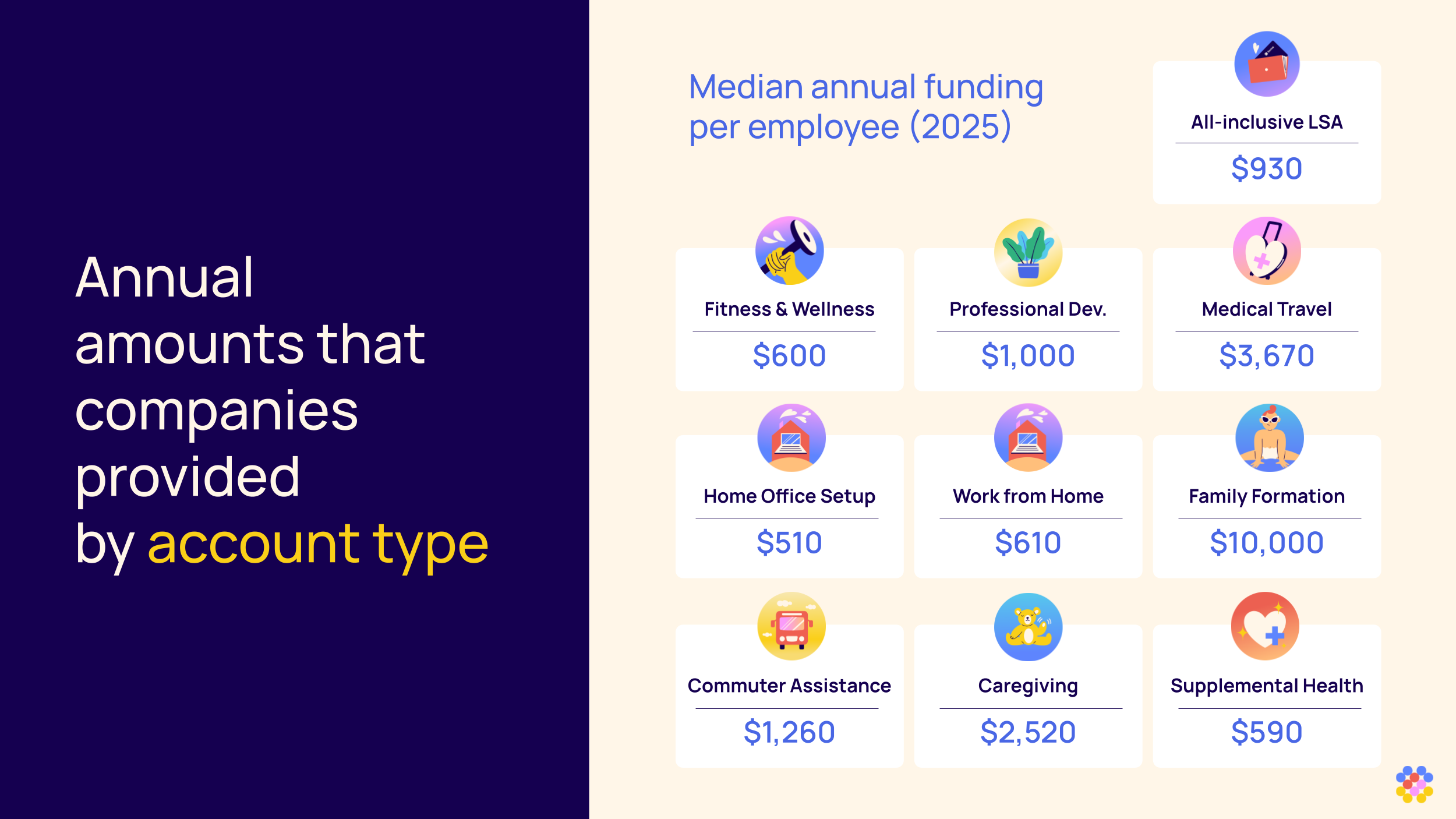
What is a Lifestyle Spending Account (LSA)? (updated for 2025)
What is a Lifestyle Spending Account (LSA)? A Lifestyle Spending Account (LSA) is an employer-sponsored flexible benefit of discretionary funds.
In this piece
Let's reimagine your benefits playbook for a moment. That standard package, health insurance, retirement, maybe some PTO, used to check all the boxes. But now, people are looking at those boxes and asking, "Is that really all there is?"
A Lifestyle Spending Account (LSA) is a benefits solution that recognizes your team members are individuals with unique needs, not interchangeable cogs in a corporate machine. While your Millennial employee might prioritize student loan repayment, your Gen-Xer might be prioritizing caregiving, and your Boomer might need financial planning to truly thrive.
LSAs aren't just another trendy perk; they're a strategic response to a workforce that increasingly values personalization over one-size-fits-all solutions. They're the difference between telling employees what they should value and trusting them to know what they actually need.
In this guide, you'll understand why forward-thinking companies are rapidly adopting LSAs and how they're transforming traditional benefits from a forgettable checkbox into a powerful tool for attraction, retention, and engagement. Whether you're looking to modernize an outdated benefits package or searching for that competitive edge in a tight talent market, LSAs might just be the solution you didn't realize you needed.
Key Takeaways
- Lifestyle Spending Accounts (LSAs) are employer-funded benefit accounts that give employees the flexibility to spend on wellness, work-life balance, and personal development expenses outside traditional benefits.
- LSAs provide personalized benefits that can include physical wellness (gym memberships, exercise equipment), mental health services, financial wellness programs, professional development, remote work support, and more.
- For employers, LSAs offer competitive differentiation, enhanced talent attraction and retention, simplified benefits administration, and cost efficiency since you only pay for what employees actually use.
- For employees, LSAs deliver greater autonomy in benefits selection, support for holistic well-being, and inclusive options that accommodate diverse personal and professional needs.
- While implementing LSAs presents some challenges like tax considerations and administrative processes, these can be effectively managed with the right platform and approach.
- Ready to explore LSAs for your organization? <span class="text-style-link text-color-blue" fs-mirrorclick-element="trigger" role="button">Schedule a consultation with Forma today</span> to learn how our customizable LSA solutions can enhance your benefits package while simplifying administration.
What is a Lifestyle Spending Account?
A Lifestyle Spending Account, also known as a well-being spending account, is a post-tax benefit that employers fund to help employees cover personal wellness expenses not typically included in traditional health plans.
LSAs offer unparalleled flexibility, allowing employees to use allocated funds for a wide range of everyday wellness needs including fitness memberships, child-care, home office equipment, mental health services, and professional development opportunities.
How does an LSA work?
LSAs are simple to use and built for flexibility. Employers allocate a set amount of funds, monthly, quarterly, or annually, for employees to spend on eligible lifestyle-related expenses.
Companies cherry pick the categories that matter most, like wellness, mental health, fitness, family care, or learning and development. Employees can either use a dedicated card for direct purchases or submit receipts for reimbursement, depending on how the program is set up.
Unlike traditional pre-tax benefits, LSA funds are considered taxable income, but the trade-off is greater flexibility and broader usage. With minimal administrative effort, LSAs allow employers to offer meaningful, personalized support that adapts to a diverse workforce.
For employees, it feels like a benefit they actually use, because it is. Whether supporting a gym membership, a meditation app, or a new skill-building course, LSAs offer real value in a format today’s employees genuinely appreciate.
How is an LSA set up?
Setting up an LSA requires several important decisions that will define how effectively it serves both your company and employees. Here is what you need to know as you build your LSA program.
- Define program objectives: Employers first determine what they want to achieve with their LSA program, whether it's enhancing employee wellness, supporting remote work, or addressing benefit gaps.
- Establish eligibility criteria: Companies decide which employees qualify for LSA benefits (full-time, part-time, contractors, etc.).
- Select benefit categories: Employers choose which expense categories will be eligible, such as fitness memberships, home office equipment, professional development classes, or pet care.
- Determine allocation amounts: Organizations set the funding amount per employee, which may vary based on position, tenure, or other factors.
- Choose a benefits platform: Many employers partner with specialized vendors like Forma to administer their LSA program, handling reimbursement claims and compliance requirements.
- Communicate the benefit: Successful implementation includes clear communication to employees about how to access and utilize their LSA funds.
How is an LSA funded?
Employers fund Lifestyle Spending Accounts as a core component of their benefits strategy. Companies typically set aside a specific amount for each employee, distributing these funds monthly, quarterly, or annually based on their program design. The allocation can vary depending on factors like an employee's position, location, or eligibility criteria.
A major advantage of LSAs lies in their budget-friendly approach to benefits management. Unlike table stakes benefits that often require fixed payments regardless of utilization, LSAs operate on a pay-for-use model. When employees do not spend their allocated funds, that money typically stays with the company, creating a more predictable and controllable benefits budget.
From a tax perspective, LSA disbursements generally count as taxable income when employees use them. This marks an important distinction from pre tax benefits such as Health Savings Accounts or Flexible Spending Accounts, making it essential for both parties to understand the tax implications.
Companies also determine what happens to unused LSA funds. Some organizations permit balances to carry forward to subsequent periods, while others implement expiration policies for unspent amounts. These decisions significantly impact how employees engage with the benefit, often influencing whether they actively use their allowances throughout the year.
What can an LSA be used for?
LSAs are typically used for wellness expenses not covered by existing traditional benefits, such as fitness classes, gym memberships, work-from-home expenses, childcare services, and more.
They can also be used to cover other lifestyle-related items such as online streaming services, food delivery programs, pet expenses, education, home office equipment, or other related items that promote both physical health and mental health.
It’s important to note that no two LSAs are the same. Your Lifestyle Spending Account's eligible expenses and parameters will depend on the specific plan offered by the employer.
However, there are some common Lifestyle Spending Account eligible expenses that most LSA-friendly businesses support. These include:
- Physical wellness: Gym memberships, exercise equipment, nutritional supplements, personal trainer sessions
- Mental well-being: Meditation apps, mental health services, stress management programs
- Financial wellness: Financial planning services, student loan repayment assistance
- Work-life balance: Childcare services, pet care, commuter benefits, fishing licenses
- Professional growth: Books, courses, professional development opportunities
- Remote work: Home office furniture, technology equipment, internet stipends
The possibilities are virtually unlimited and selected based on where organizations want to direct their benefits investments. LSAs deliver value for both companies and team members by giving employees the power to discover and select meaningful benefits that align with their personal circumstances.
Companies benefit from a dynamic benefits approach with countless customization options, a strategy that withstands inflation, and the agility to adapt as workforce needs evolve. LSAs continue to gain traction as more organizations recognize the strategic advantages these accounts provide.
For a comprehensive analysis of current LSA trends and the categories businesses are prioritizing, take a look at our Forma’s 2025 Lifestyle Spending Account benchmark report.
LSA Expense Categories
Lifestyle Spending Accounts can be designed to address employee wellbeing across multiple dimensions, extending far beyond traditional benefits that focus only on physical health. Organizations implementing LSA programs through flexible, customizable platforms like Forma recognize that meaningful support requires addressing the complete spectrum of human needs, from daily wellness activities to major life transitions.
This comprehensive approach directly correlates with higher employee satisfaction and retention rates, particularly among distributed teams where one-size-fits-all perks fail to deliver consistent value across locations and life stages.
This list shares example LSA categories with typical eligible expenses. (Keep in mind, LSAs are customizable and each organization can design them to their own unique needs and priorities.)
Physical Wellness & Fitness
- Gym memberships and fitness center access
- Exercise equipment for home workouts
- Personal training sessions and coaching
- Fitness classes (yoga, Pilates, spin, martial arts)
- Athletic event registration fees (marathons, triathlons)
- Nutritional supplements and wellness products
- Sports league and athletic club memberships
Mental Health & Emotional Wellbeing
- Therapy and counseling services
- Meditation and mindfulness apps (Calm, Headspace)
- Stress management programs
- Massage therapy and acupuncture
- Mental health apps and digital wellness tools
- Life coaching and health coaching services
- Relaxation and spa treatments
Professional Development & Career Growth
- Online courses and certifications (Coursera, LinkedIn Learning, Udemy)
- Conference registrations and industry events
- Career coaching and mentorship programs
- Books and educational materials
- Language learning programs (Rosetta Stone, Babbel)
- Professional licensing fees and exam costs
- Skill-building workshops and seminars
Family Support & Caregiving
- Childcare and daycare expenses
- Babysitting and nanny services
- Eldercare and in-home support services
- Fertility treatments and family-forming benefits
- Adoption and surrogacy-related costs
- Parenting classes and support programs
- Pet care expenses (veterinary bills, insurance, supplies)
Remote Work & Home Office
- Home office furniture and ergonomic equipment
- Technology equipment (monitors, keyboards, standing desks)
- Internet and cell phone services
- Coworking space memberships
- Office supplies and accessories
- Workspace upgrades and productivity tools
Financial Wellness & Planning
- Financial planning consultations
- Student loan repayment assistance
- Retirement planning services
- Debt management programs
- Legal services (will creation, estate planning)
- Identity theft protection
- Tax preparation assistance
Food, Nutrition & Daily Essentials
- Meal delivery services (HelloFresh, Blue Apron)
- Grocery purchases and healthy food options
- Nutritionist consultations
- Meal planning services
- Restaurant meals during work hours
- Office snacks for remote employees
Commuter & Transportation Benefits
- Transit passes and public transportation
- Parking fees and permits
- Bike purchases and maintenance
- Ride-share services for work-related travel
- Electric vehicle charging costs
- Eco-friendly commuting options
Personal Enrichment & Experiences
- Museum and cultural institution memberships
- Concert, theater, and entertainment tickets
- Streaming services and digital subscriptions
- Hobby-related expenses and creative pursuits
- Travel experiences and exploration
- Theme park passes and recreational activities
For a detailed compliance guide on Lifestyle Spending Account eligible expenses, review our comprehensive resource.
How much should you allocate? LSA funding benchmarks by category
Setting competitive funding levels for your Lifestyle Spending Account program requires balancing employee needs with organizational budget constraints. Organizations scaling globally typically benchmark their LSA allocations against industry standards to remain competitive in talent markets while maintaining cost efficiency.
The allocation strategy you choose signals which aspects of employee wellbeing your organization prioritizes. Companies in healthcare and retail industries tend to allocate higher amounts for wellness and family support categories, reflecting the physical demands and caregiving responsibilities common among their workforces.
Meanwhile, media and automotive companies often emphasize professional development and remote work stipends to support continuous learning and distributed team structures.
When determining your funding levels, consider both the per-employee annual allocation and the disbursement cadence. Quarterly funding schedules tend to drive higher utilization rates compared to annual lump sums, as employees perceive smaller, regular amounts as more accessible for everyday expenses rather than reserved for major purchases.
Organizations scaling benefits programs across multiple currencies and locales should also account for regional cost-of-living variations to ensure equitable access to meaningful benefits.
Lifestyle Spending Account Funding Ranges by Category

Data compiled from Forma platform benchmarks and industry analysis. Actual allocations should reflect your organization's budget, industry, and workforce demographics.
Benefits of offering an LSA
While LSAs provide numerous advantages, it's worth discussing exactly how they deliver value. Here are the standout benefits for both employers and employees, showcasing why this flexible approach is becoming the go-to solution in contemporary workplaces:
LSA benefits for employers
LSAs help companies differentiate themselves in a competitive talent market by offering unique, customizable benefits that go beyond traditional health insurance. These programs address the full spectrum of employee well-being, physical, mental, and lifestyle, making them more appealing to your workforce.
They also play a significant role in talent attraction and retention. According to our 2022 LSA benchmark report, LSAs add 50% more perceived value to your company benefits as opposed to table stakes benefits. They’re becoming an expected part of competitive compensation packages, particularly among high performers.
Beyond recruitment, LSAs contribute to increased employee satisfaction. When employees feel supported in ways that matter to them personally, they’re more likely to be engaged, motivated, and loyal. This results in a stronger workplace culture and improved overall morale.
LSAs also offer flexible benefits management for employers. Unlike traditional benefits, which are often rigid and slow to adapt, LSAs can be quickly updated to reflect shifting employee preferences or business priorities, allowing companies to stay agile and responsive.
LSA benefits for employees
LSAs offer personalized benefits by letting employees direct funds toward what truly matters in their lives. Whether funding a gym membership, therapy sessions, professional courses, or childcare assistance, LSAs provide the freedom to address individual priorities rather than forcing everyone into identical benefits boxes. This relevance transforms benefits from a standard offering into something genuinely valued.
They also foster holistic well being, acknowledging that employee wellness extends far beyond physical health alone. LSAs can support mental health resources, financial planning tools, and career development opportunities. By encompassing a wider spectrum of wellness categories, these accounts help team members feel supported across all dimensions of their lives, both personally and professionally.
In our increasingly diverse and distributed workforce, LSAs deliver an inclusive approach to benefits. Team members across different locations, life stages, and cultural backgrounds can access resources reflecting their specific circumstances. This adaptability makes LSAs particularly valuable in today's flexible work landscape.
Most significantly, LSAs provide employees with greater autonomy. The freedom to allocate benefit dollars empowers individuals and enhances the perceived value of their total compensation. When people feel trusted to make their own decisions about benefits, both satisfaction and engagement naturally increase.
What are the challenges of a Lifestyle Spending Account?
While LSAs offer numerous advantages, there are some implementation challenges to consider. With the right approach, these can be effectively managed:
LSA challenges for employers
- Tax management: LSA benefits are generally taxable, requiring appropriate withholding and reporting on employee income taxes. However, modern LSA platforms like Forma can handle tax calculations and reporting automatically, ensuring compliance while reducing administrative burden.
- Administrative processes: Without proper systems, tracking eligible expenses and processing reimbursement claims can be time-consuming. Fortunately, a third-party administrator (TPA) like Forma streamlines these processes, allowing HR teams to focus on strategic initiatives rather than paperwork.
- Budget predictability: Compared to fixed benefits, LSA utilization rates can fluctuate throughout the year. The advantage here is that employers only pay for what employees actually use, potentially reducing overall benefit costs while providing real-time visibility into program utilization.
LSA challenges for employees
- Tax awareness: Unlike pre-tax benefits, LSA reimbursements typically count as taxable income. Clear communication about tax implications helps set proper expectations, and many employees still find the benefit valuable despite the tax considerations. However, once again, your benefits platform usually takes over this process and streamlines communication with your employees.
- Program parameters: The specific eligible expenses are determined by the employer based on organizational priorities. This structure allows programs to evolve based on employee feedback, but there is a chance that the employers may not set up the program correctly to be suitable for all users.
- Fund management: Some LSA programs have expiration policies for unused funds. These policies can encourage timely benefit utilization while giving employers budget predictability and well-designed platforms provide timely reminders to help employees maximize their allocated funds.
10 reasons companies need to switch to Lifestyle Spending Accounts
Lifestyle Spending Accounts boost team well-being, draw exceptional talent, and deliver inclusive benefits. Organizations lower their overall expenses and can swiftly adapt to global developments. Benefits teams escape the administrative headaches of managing multiple point solutions. Above all, every employee gains the power to channel benefit allowances toward what truly matters in their personal circumstances.
Here are the top ten reasons organizations should embrace Lifestyle Spending Account benefits below.
- LSAs grow benefits without growing budget: Multiple point solutions can add up when HR leaders try to address all the areas of wellness. Consolidating under one holistic flexible benefit solution can actually increase the perceived value of that benefit by up to 50% as reported in the Forma LSA benchmark report.
- Differentiate your company: 85% of employees say their companies don’t support their careers. By offering LSAs, you demonstrate a commitment to employee growth and well-being.
- Only pay for what employees actually use: If an employee is allocated $100 but only spends $50, the remaining funds stay with the company. This usage-based model helps control costs.
- You foster well-being in the workplace: Employer-chosen benefits see member engagement hovering around 36%.
- You can attract and retain the best employees: Employees are 1.6x more likely to stay at their company when they are satisfied with their wellness benefits.
- Reduced administrative burdens: 60% of employers are feeling the pain of point solution fatigue. A flexible solution consolidates vendors and alleviates this headache.
- Employees get to choose benefits that matter most to them: A Randstad survey found that 94 percent of employees want benefits that meaningfully impact their quality of life.
- Companies can quickly respond to world events: Lifestyle Spending Accounts can be set up in as little as 5-10 days. For example, some employers set up emergency relief accounts to support their employees in Ukraine when the international conflict started.
- Companies can actually save money: Companies can reduce costs by avoiding flat-rate benefit expenses and instead funding based on actual employee usage, making LSAs a smarter, more efficient way to manage benefits spending.
- Equitable DEI flexibility can address benefits gaps: In a recent Gallup poll, 42% of workers said DE&I initiatives were an important part of their next job.
Are there any disadvantages to LSAs?
Like any benefits solution, Lifestyle Spending Accounts come with considerations that HR leaders should understand before implementation. The most commonly cited concerns involve tax treatment, administrative setup, and employee education requirements.
However, these challenges become manageable when organizations approach implementation strategically with clear communication and the right technology partner.
1. Tax treatment complexity
LSA reimbursements are typically considered taxable income for employees, unlike pre-tax benefits such as HSAs or FSAs. This means employees may see tax withholdings on their LSA funds, and employers must ensure accurate reporting and compliance.
How to Address It: Modern benefits platforms automate tax classification and payroll integration, handling tax treatment in real-time and syncing seamlessly with payroll systems. Clear upfront communication about tax implications during enrollment sets proper expectations, and many employees still find tremendous value in LSAs despite the tax treatment because the benefits directly address their personal needs.
2. Program design and communication requirements
Employees need clear guidance on eligible expenses, submission processes, and program rules. Without proper communication, adoption rates may suffer as employees remain uncertain about how to use their benefits.
How to Address It: Comprehensive communication templates, employee onboarding materials, and ongoing support resources make program education straightforward. Intuitive platforms with built-in expense category descriptions, real-time balance tracking, and mobile receipt submission reduce confusion. After initial rollout, most LSA programs require minimal ongoing administration.
3. Benefits budget tightening
Some finance teams worry about budgeting for LSAs since utilization rates can vary, making it difficult to forecast exact costs compared to fixed-price point solutions.
How to Address It: This concern actually reveals one of LSA's greatest strengths—you only pay for benefits employees actually use. Unlike fixed vendor contracts where you pay regardless of engagement, LSAs operate on a reimbursement model that protects your budget. Real-time reporting and historical benchmarking data allow finance teams to forecast utilization with high accuracy. You maintain complete control over funding amounts, eligible categories, and rollover policies, giving you multiple levers to manage costs while delivering meaningful benefits.
Get started with a Lifestyle Spending Account from Forma
Ready to offer benefits your employees will actually use and love? Forma is the leading provider of Lifestyle Spending Accounts, trusted by companies like Honda, lululemon, and Tripadvisor to deliver personalized, flexible, and easy-to-manage employee benefits.
Our platform allows you to design LSAs that align with your culture and workforce needs, whether you’re supporting wellness, family care, professional development, or all of the above.
Forma takes care of the complexity so you don’t have to. From compliance and tax handling to claims processing and employee support, everything is built into one seamless platform.
Here’s why companies choose Forma:
- Flexible benefit design: Easily configure spending categories, eligibility rules, and budgets to fit your team’s needs.
- Global scalability: Offer consistent benefits in over 100 countries with localized support and currency handling.
- Multiple payment options: Let employees spend via preloaded card, reimbursement, or the curated Forma Store.
- Real-time insights: Track usage, engagement, and ROI with powerful reporting tools.
- Effortless administration: We handle compliance, communication, and backend processes so your HR team doesn’t have to.
<span class="text-style-link text-color-blue" fs-mirrorclick-element="trigger" role="button">Schedule a consultation</span> with Forma to learn about Lifestyle Spending Accounts and how they can benefit your team.
Lifestyle Spending Accounts (LSAs) FAQS
What is the difference between a Lifestyle Spending Account and an HSA?
A Lifestyle Spending Account (LSA) is funded by employers to cover a broad range of wellness and personal development expenses, potentially taxable to the employee. On the other hand, a Health Savings Account (HSA) is a tax-advantaged account for those with high-deductible health plans, funded by both employers and employees, used exclusively for medical expenses.
How are Lifestyle Spending Accounts taxed?
Lifestyle Spending Accounts (LSAs) are usually funded by employers, and the taxation depends on local laws. Often, the benefits from LSAs are considered taxable income to the employee. This means the value of the LSA benefits may be added to the employee's gross income and taxed accordingly. If you need tax or legal advice, please consult with counsel or a certified tax professional.
Where can I find more information on LSA tax?
For detailed information on how to approach Lifestyle Spending Accounts as a taxable benefit, consult a tax professional, your employer's human resources department, or the official website of your country or state's tax authority.
These sources can provide the most accurate and up-to-date information tailored to your situation and jurisdiction.
What's the best way to flag taxable vs. pre-tax expenses in a lifestyle spending account so payroll picks it up?
The most effective approach is using a benefits administration platform that automatically categorizes expenses at the point of reimbursement based on IRS guidelines. The system should tag each transaction as taxable or non-taxable in real-time, then export this data directly to your payroll system with the proper tax treatment already applied. Common non-taxable LSA categories include work-related internet and cell phone reimbursements, qualified educational assistance up to $5,250 annually, and employee student loan repayments within IRS limits. All other categories—wellness, fitness, family support, food, and personal development—are typically taxable. Your platform should generate a report each pay period showing taxable LSA amounts that need to be added to employees' gross income, eliminating manual tracking and reducing compliance risk.
How do you communicate a lifestyle spending account as part of total compensation?
Include LSA value in your total rewards statements alongside salary, healthcare, retirement contributions, and other benefits. Express it as an annual dollar amount (e.g., "$1,200 annual LSA for wellness and professional development") rather than vague descriptions. During recruitment, present LSAs as a differentiator that gives candidates flexibility to customize their benefits based on life stage and personal priorities. For current employees, use concrete examples in communications: "Your $1,200 LSA could cover a gym membership, therapy sessions, childcare assistance, or professional courses—you choose what matters most." Calculate and share the effective hourly rate increase the LSA represents (e.g., a $1,200 annual LSA equals approximately $0.58/hour for full-time employees). During benefits enrollment and in ongoing communications, emphasize that LSA funds are in addition to traditional benefits, highlighting the total compensation value employees receive beyond base salary.














